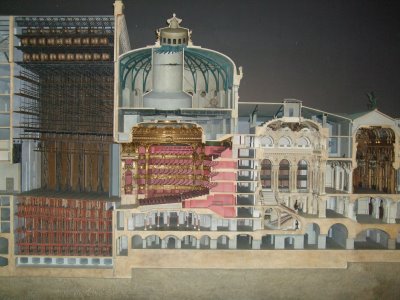Charles Garnier, The Paris Opéra, 1860-75
The Paris Opéra (1860-75), designed by Charles Garnier, is one of the jewels of Napoleon III’s newly reconstructed city. Frequented by Degas and the source for much of his ballet imagery, the Paris Opéra is key to understanding the somewhat perverse culture of voyeurism and spectacle among the prosperous classes of the Second Empire.

Charles Garnier, Paris Opéra, 1860-75, masonry walls with concealed iron floors (photo: Juanedc, CC BY 2.0)
Marvin Trachtenberg & Isabel Hyman have called the huge Opéra house,
the new cathedral of bourgeois [middle, really upper-middle class] Paris…. The glittering centerpiece of the new Paris….was meant to be much more than a theater in the ordinary sense. For Charles Garnier, an architect of the Ecole des beaux-arts, it was a setting for a ritual in which the spectators were also actors, participants in the rite of social encounter, seeing and being seen.
The division of the structure supports his vision.

Cross-section diagram of the Paris Opéra
Look at the cross-section. The dome sits above the audience and orchestra, the high roof over the stage. Behind the stage are the rehearsal rooms where Degas often sketched.

Charles Garnier, the auditorium and stage of the Paris Opéra, 1860-75 (photo (shadows reduced): Naoya Ikeda, CC BY-SA 3.0)
But the single largest area, from the front facade to the seats below the dome, is reserved for the foyers and the grand stair hall. This area was, in essence, a second stage. Far more ornate then the performance stage, the lobbies of the Paris Opéra were where the social dramas of the rich were enacted.

Charles Garnier, The Grand Foyer of the Paris Opéra, 1860-75 (photo: Degrémont Anthony, CC BY-SA 3.0)
Strolling along the new boulevards or posing in the opera’s grand foyers, the ruling classes paraded their wealth. The flâneur, a new denizen of the city, was a man of leisure (itself a by-product of the capital generated by industrialization). Walking the streets not for work or need, but for the pleasures of observation, the flâneur was at home in the Opéra.
Additional resources:
Virtual visit to the Paris Opéra from Google Cultural Institute
Garnier’s Paris Opéra in Google’s Streetview
Charles Garnier biography from Great Buildings
Smarthistory images for teaching and learning:
[flickr_tags user_id=”82032880@N00″ tags=”garnier,”]

